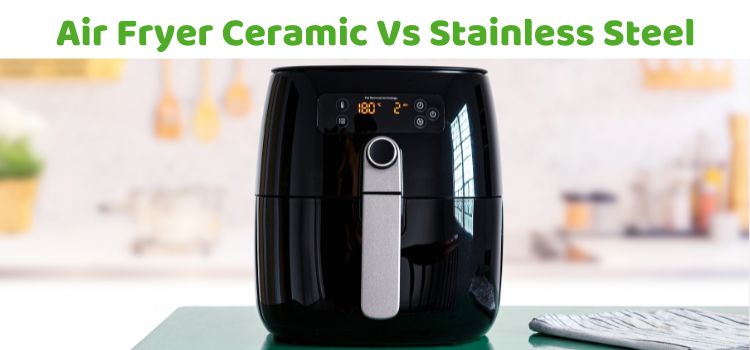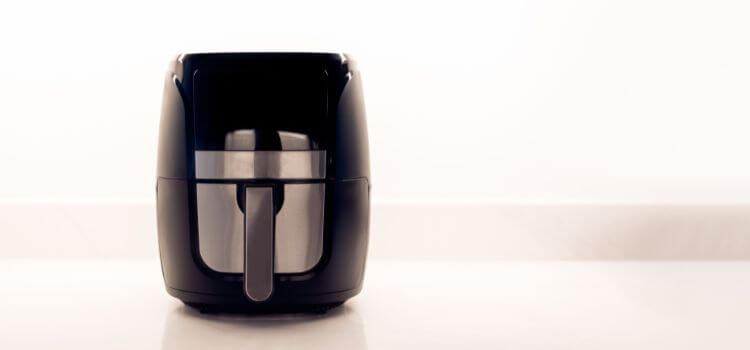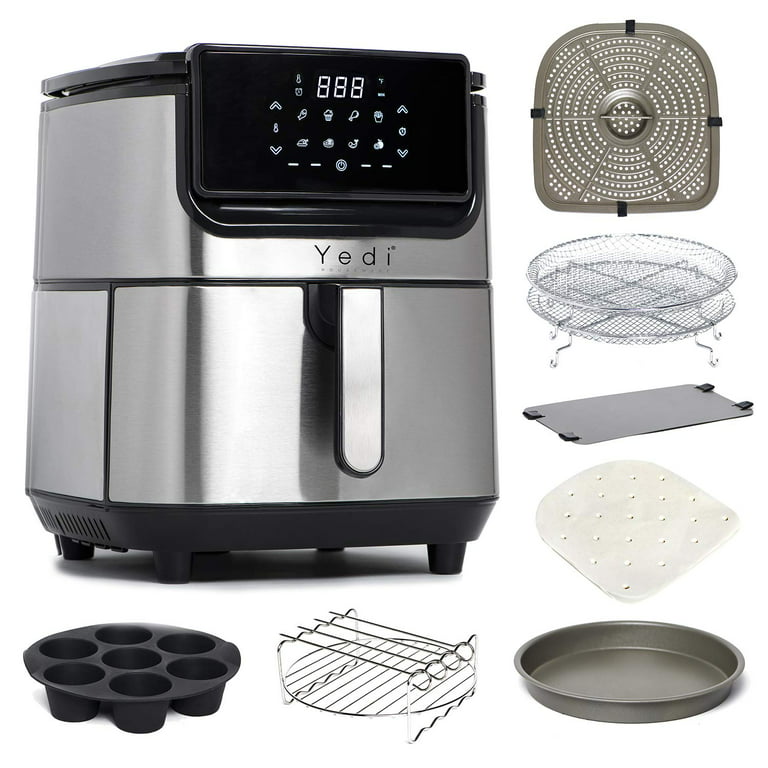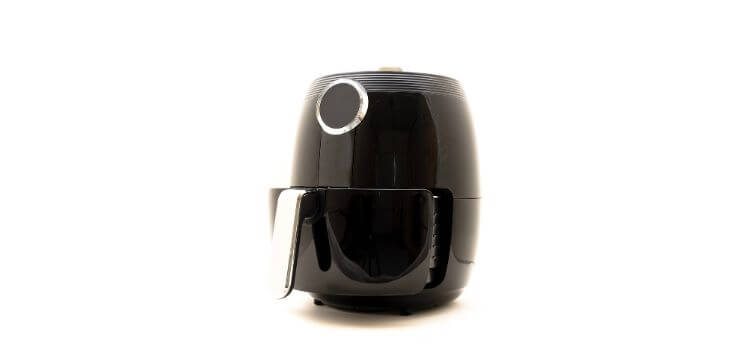As an Amazon Associate, I earn from qualifying purchases

Air fryer ceramic and stainless steel models differ mainly in their coating and durability. Ceramic air fryers offer a non-stick surface without chemicals, while stainless steel versions are known for their longevity.
Choosing between a ceramic or stainless steel air fryer can influence your cooking experience and the longevity of the appliance. Ceramic-coated air fryers are praised for their non-toxic, non-stick surfaces, which make for easy cleaning and potentially healthier cooking without the need for additional fats.
However, this coating may wear off over time and with high-temperature cooking. On the other hand, stainless steel air fryers are celebrated for their robustness and resistance to rust and corrosion, ensuring a longer lifespan. They can withstand higher temperatures without the risk of peeling or flaking. While they may not be inherently non-stick, their durability makes them a favored choice for frequent users. Your decision will hinge on what you prioritize: the natural non-stick convenience of ceramic or the enduring resilience of stainless steel.
Introduction To Air Fryer Materials
Air fryers have changed the way we cook. They offer a healthier option to traditional frying. These handy appliances come in various materials. The most common are ceramic and stainless steel. Each material has its own benefits.
The Rise Of Air Fryers
Air fryers have gained popularity quickly. They use hot air to cook food. This method reduces oil use. Many kitchens now feature these devices. They promise crispy textures with less fat.
Ceramic Vs. Stainless Steel: The Basics
Choosing between ceramic and stainless steel can be tough. Here are the basics:
- Ceramic air fryers are non-stick. They are easy to clean.
- Stainless steel air fryers are durable. They can handle high heat.
Both materials have pros and cons. Your choice depends on your cooking style and needs.
Pros And Cons Of Ceramic Air Fryers
Choosing an air fryer involves considering the cooking surface. Ceramic air fryers offer unique benefits and limitations. Let’s dive into the details of ceramic-coated air fryers.
Advantages Of Ceramic Coating
- Non-Toxic: Ceramic coatings are free from harmful chemicals like PTFE and PFOA.
- Non-Stick: Food easily slides off, reducing the need for excess oil.
- Easy to Clean: Their smooth surface makes them simpler to wipe down.
- Durable: Resistant to scratches and withstands high temperatures.
- Healthy Cooking: Less oil means fewer calories and fats.
Limitations Of Ceramic Air Fryers
- Price: Ceramic models can be more expensive than stainless steel.
- Lifespan: The coating may wear quicker than expected without proper care.
- Sensitivity: Abrasive cleaners or metal utensils can damage the surface.
- Heat Distribution: May not always be as even as metal interiors.
- Choice: Fewer models available compared to stainless steel options.
Pros And Cons Of Stainless Steel Air Fryers
Choosing between air fryer materials is crucial for your cooking experience. Stainless steel options are popular. They offer durability and style. Yet, they have some drawbacks too. Let’s explore the advantages and disadvantages of stainless steel air fryers.
Benefits Of Stainless Steel
- Durability: Stainless steel withstands drops and dents.
- Heat Distribution: It heats evenly for consistent cooking.
- Easy Cleaning: Wipe it down for a shiny finish.
- No Odor Retention: Cooking smells don’t linger.
- Sleek Design: They look modern in any kitchen.
- Less Chemical Exposure: Fewer coatings mean safer meals.
Drawbacks Of Stainless Steel Models
- Price: They can be more expensive.
- Weight: Heavier to move around.
- Heat Conduction: The exterior may get hot.
- Fingerprints: Marks show up easily.
Health And Safety Considerations

Choosing between ceramic and stainless steel in air fryers is important. Health and safety are top priorities in your kitchen. Let’s explore how these materials measure up.
Toxicity Concerns With Cookware
Ceramic air fryers are often celebrated for being non-toxic. They are free from PTFE and PFOA, chemicals found in some non-stick coatings that can cause health issues. Ceramic is a natural material that does not leach chemicals into food.
In contrast, stainless steel is also a safe choice. It’s known for its resistance to rust and corrosion. High-quality stainless steel does not contain harmful chemicals and does not react with acidic foods.
Heat Distribution And Cooking Safety
Ceramic-coated baskets tend to heat evenly, ensuring well-cooked meals. They can handle high temperatures without releasing harmful fumes.
Stainless steel is a champion of even heat distribution. It is durable and can withstand frequent use. This means your food cooks evenly every time.
| Feature | Ceramic | Stainless Steel |
|---|---|---|
| Toxicity | Low | Low |
| Heat Distribution | Even | Very Even |
| Safety | High Temp Safe | Durable |
Durability And Lifespan
Durability and lifespan are key factors in choosing an air fryer. You want a device that stands up to frequent use without showing wear and tear. This section compares the longevity of ceramic and stainless steel air fryers.
Comparing Durability
When selecting an air fryer, consider how well it will hold up over time. Ceramic and stainless steel options offer different advantages:
- Ceramic: Resists scratches; however, may chip over time.
- Stainless Steel: Known for resisting rust and corrosion.
Maintenance And Care
Keeping your air fryer in top condition extends its lifespan. Here’s how to care for each type:
| Ceramic Air Fryer | Stainless Steel Air Fryer |
|---|---|
| Use gentle sponges to avoid surface damage. | Withstand harsher scrubbing; easier to clean. |
| Avoid sudden temperature changes. | Durable under various temperatures. |
Performance And Cooking Results
Performance and Cooking Results often dictate kitchen appliance choices. In the world of air fryers, material matters. Ceramic and stainless steel models compete for supremacy on countertops. Each offers unique benefits that influence cooking efficiency, taste, and texture. Let’s dive into how these materials impact your culinary creations.
Cooking Efficiency
Air fryers with ceramic interiors heat up quickly. They distribute heat evenly. This leads to faster cooking times. Stainless steel air fryers excel in durability. They retain heat well, ensuring consistent temperatures throughout cooking.
- Ceramic heats up fast and saves time
- Stainless steel maintains steady heat
Taste And Texture Differences
The material of your air fryer can affect your food’s final flavor and crunch. Ceramic-coated baskets are non-reactive. They won’t change the taste of your dishes. Stainless steel is also taste-neutral. But it may contribute to a crispier exterior on foods.
| Material | Taste Impact | Texture Outcome |
|---|---|---|
| Ceramic | Neutral | Evenly cooked |
| Stainless Steel | Neutral | Crispier surface |
Environmental Impact
Choosing an air fryer impacts our planet. Air Fryer Ceramic vs Stainless Steel – each has different effects. Let’s explore their Environmental Impact.
Eco-friendly Aspects
Ceramic and Stainless Steel air fryers offer eco-friendly features. Yet, they differ significantly.
- Ceramic air fryers heat quickly, using less energy.
- Stainless Steel models last longer, reducing waste.
Both options cut down on oil use, making them better for the environment than deep frying.
Recyclability And Disposal
End-of-life disposal is critical for environmental impact.
| Type | Recyclable | Disposal Ease |
|---|---|---|
| Ceramic | Partly | Harder |
| Stainless Steel | Yes | Easier |
Stainless Steel air fryers are fully recyclable. They are easier to dispose of responsibly.
Ceramic models can be harder to recycle. Some parts may not be recyclable.

Cost Analysis
Cost Analysis plays a vital role in choosing between air fryer ceramic and stainless steel models. Let’s dive into the financial aspects to make a smart decision.
Price Range Comparison
Both ceramic and stainless steel air fryers come in various prices. Yet, patterns emerge that can guide buyers.
- Ceramic air fryers typically start at a lower price point.
- Stainless steel models often represent a higher initial investment.
| Type | Low Range | High Range |
|---|---|---|
| Ceramic | $50 | $150 |
| Stainless Steel | $100 | $300+ |
Value For Money
Beyond initial costs, consider value over time.
Ceramic air fryers are budget-friendly but may wear faster.
Stainless steel models cost more but last longer.
- Durability is key with stainless steel.
- Ceramic options are great for short-term savings.
- Consider long-term use and replacement costs.
Consumer Preferences And Trends
Consumer Preferences and Trends in kitchen appliances constantly evolve as technology advances. Among the hottest topics is the debate between air fryers with ceramic and stainless steel interiors. Health-conscious consumers and home chefs alike weigh in on this matter, influencing market offerings and brand innovations.
Popular Models And Brands
The market teems with air fryer models that cater to diverse preferences. Brand reputation and quality construction often guide consumer choices.
- Ceramic air fryers boast non-stick convenience and chemical-free cooking surfaces.
- Stainless steel counterparts promise durability and a sleek kitchen aesthetic.
| Brand | Model | Type |
|---|---|---|
| Philips | Avance | Stainless Steel |
| Ninja | Foodi | Ceramic |
| Cuisinart | TOA-60 | Stainless Steel |
User Reviews And Feedback
User experiences play a crucial role in shaping purchase decisions. Online reviews and ratings reflect customer satisfaction.
- Users praise ceramic for its easy clean-up and health benefits.
- Stainless steel fans highlight its longevity and consistent performance.
Common feedback for ceramic and stainless steel air fryers includes:
- Cooking efficiency
- Taste and texture of food
- Appliance maintenance
Final Verdict: Which Is Better?

Choosing between an air fryer with a ceramic or stainless steel basket? It’s crucial. Both have unique benefits. But one might suit your needs better. Let’s explore this further.
Making The Right Choice For Your Kitchen
Consider your cooking habits. Do you cook often? Do you need easy cleanup? Answer these to decide. Below, find a comparison:
- Ceramic: Non-stick, easy to clean, but can chip.
- Stainless Steel: Durable, scratch-resistant, but may stick.
Think about health. Ceramic is often free of PTFE and PFOA. These are chemicals you might want to avoid.
Check your budget. Ceramic can cost more. But it could be worth it for its features.
Look at longevity. Stainless steel lasts longer. It can handle high heat better.
Future Of Air Frying Technology
Air fryers are evolving. We see more options with smarter features. Ceramic and stainless steel will improve too. Here’s what might come:
- Enhanced coatings for ceramics
- Stainless steel with better non-stick properties
- Smart technology for precise cooking
Imagine air fryers that learn your recipes. Or ones that clean themselves. The future is exciting!
Frequently Asked Questions
Which Is Healthier: Ceramic Or Stainless Steel Air Fryer?
Ceramic air fryers typically have a non-stick coating that’s free from PTFE and PFOA, chemicals found in traditional non-stick coatings. This makes them a healthier choice as they minimize the risk of these chemicals leaching into food.
Can Stainless Steel Air Fryers Affect Food Taste?
Stainless steel air fryers do not affect the taste of food. They provide a neutral cooking environment without imparting any additional flavors, ensuring that the food’s taste remains unaltered.
How Durable Are Ceramic Air Fryers Compared To Stainless Steel?
Stainless steel air fryers generally offer greater durability compared to ceramic ones. Ceramic coatings can chip or wear over time, while stainless steel is resistant to scratches and can withstand higher levels of wear and tear.
Are Ceramic Air Fryers Easier To Clean Than Stainless Steel?
Ceramic air fryers often have a non-stick surface, making them very easy to clean. Food residue typically wipes away with minimal effort. Stainless steel may require more scrubbing if food gets baked on.
Conclusion
Choosing between air fryer ceramic and stainless steel models boils down to personal preference. Both offer distinct benefits, from ceramic’s non-toxic surface to stainless steel’s durability. Consider your cooking habits, health concerns, and kitchen aesthetics. Ultimately, the right choice enhances your culinary experience, making meal prep both enjoyable and efficient.
As an Amazon Associate, I earn from qualifying purchases